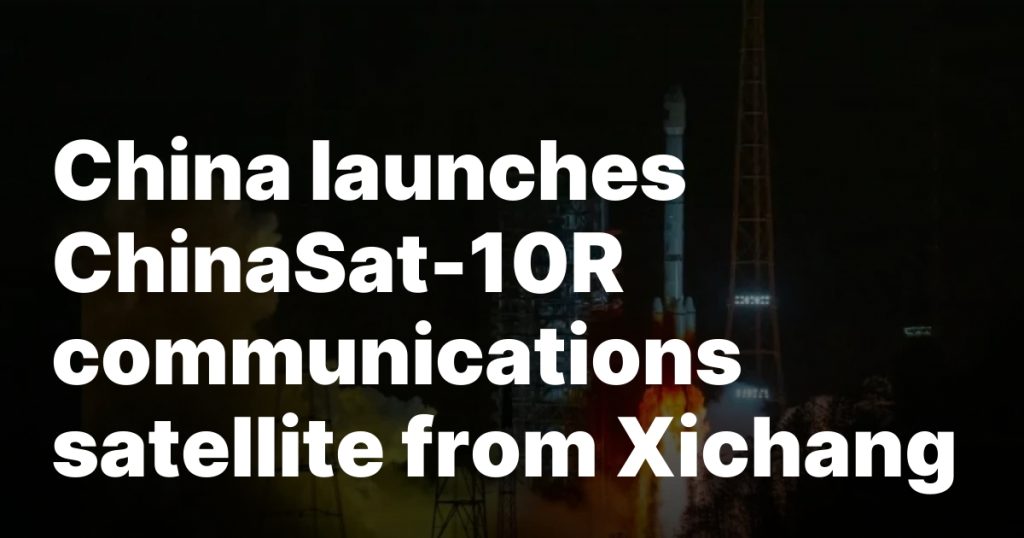HELSINKI — China launched a new communications satellite into geosynchronous transfer orbit Saturday to replace the aging ChinaSat-10 spacecraft.
A Long March 3B rocket lifted off at 7:11 a.m. Eastern (1211 UTC) Feb. 22 from Xichang Satellite Launch Center in southwest China. Exhaust from the rocket illuminated launch infrastructure around the pad as the launch vehicle climbed into the night sky.
The China Aerospace Science and Technology Corporation (CASC), the country’s state-owned main space contractor, confirmed launch success, revealing the previously undisclosed payload to be the ChinaSat-10R (Zhongxing-10R) communications satellite. U.S. Space Force space domain awareness later cataloged the satellite in geosynchronous transfer orbit (GTO).
“The ChinaSat-10R satellite will mainly provide satellite communication services to users in China’s transportation, emergency response, energy, forestry, and grassland sectors, as well as countries and regions along the Belt and Road,” a CASC statement read.
CASC did not immediately provide information on which DFH satellite bus the satellite is based on, nor details regarding transponders and bands used, which would help clarify its exact capabilities. The original ChinaSat-10 was launched in 2011 and positioned at 110.5 degrees East on the geostationary belt, 35,786 kilometers above the equator.
The Belt and Road aspect of the new satellite’s role highlights China’s aim of enhancing geopolitical influence through satellite diplomacy, while also improving the country’s satellite infrastructure.
ChinaSat, also known as Zhongxing, is a series of communications satellites operated by China Satellite Communications Co., Ltd. (China Satcom), a CASC subsidiary. The satellite series provides a range of communications services, including television broadcasting, internet connectivity, radio transmission, secure military communications, VSAT (Very Small Aperture Terminal) networks, and mobile communications.
The Long March 3B and the satellite were produced by CASC’s China Academy of Launch Vehicle Technology (CALT) and China Academy of Space Technology (CAST) respectively.
Despite CASC developing the Long March 7A kerosene-liquid oxygen launcher for missions to geosynchronous transfer orbit, the older, hypergolic Long March 3B remains a workhorse for such missions. The rocket is scheduled to launch the Tianwen-2 near-Earth asteroid sample return and main belt comet rendezvous mission in the coming months. Previously, it launched the Chang’e-4 lunar far side landing mission in 2018.
The launch was China’s eighth orbital launch attempt of the year. It follows the debut flight of the Long March 8A rocket Feb.11, carrying a second batch of Guowang megaconstellation satellites into orbit.
CASC has yet to publish an overview of China’s plans for the year, but is expected to do so later this month. The country may once again attempt to reach around 100 launches—as targeted for 2024—or more. Commercial launch companies headquartered in Beijing are aiming for a collective total of around 40 launches, according to officials at a recent commercial space conference.
China is scheduled to launch the crewed Shenzhou-20 and -21 missions and a Tianzhou cargo resupply spacecraft to the Tiangong space station in 2025. A pair of new, smaller cargo spacecraft could also fly to Tiangong on new commercial rockets this year. China also aims to debut a number of new Long March and potentially reusable commercial rockets during 2025.
Commercial launch service provider Galactic Energy is set to launch a Ceres-1 solid rocket Feb. 25 from Jiuquan spaceport in northwest China. A Long March 2C rocket is expected to launch Feb. 27, also from Jiuquan, carrying an as yet unknown payload.








